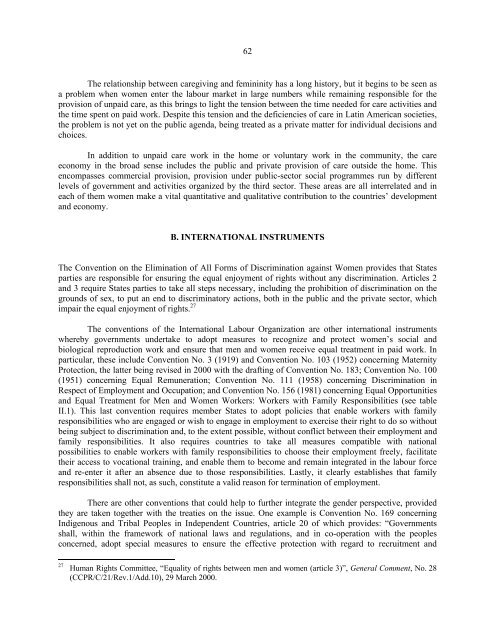Women in Latin America and the Caribbean - Cepal
Women in Latin America and the Caribbean - Cepal
Women in Latin America and the Caribbean - Cepal
Create successful ePaper yourself
Turn your PDF publications into a flip-book with our unique Google optimized e-Paper software.
62<br />
The relationship between caregiv<strong>in</strong>g <strong>and</strong> fem<strong>in</strong><strong>in</strong>ity has a long history, but it beg<strong>in</strong>s to be seen as<br />
a problem when women enter <strong>the</strong> labour market <strong>in</strong> large numbers while rema<strong>in</strong><strong>in</strong>g responsible for <strong>the</strong><br />
provision of unpaid care, as this br<strong>in</strong>gs to light <strong>the</strong> tension between <strong>the</strong> time needed for care activities <strong>and</strong><br />
<strong>the</strong> time spent on paid work. Despite this tension <strong>and</strong> <strong>the</strong> deficiencies of care <strong>in</strong> Lat<strong>in</strong> <strong>America</strong>n societies,<br />
<strong>the</strong> problem is not yet on <strong>the</strong> public agenda, be<strong>in</strong>g treated as a private matter for <strong>in</strong>dividual decisions <strong>and</strong><br />
choices.<br />
In addition to unpaid care work <strong>in</strong> <strong>the</strong> home or voluntary work <strong>in</strong> <strong>the</strong> community, <strong>the</strong> care<br />
economy <strong>in</strong> <strong>the</strong> broad sense <strong>in</strong>cludes <strong>the</strong> public <strong>and</strong> private provision of care outside <strong>the</strong> home. This<br />
encompasses commercial provision, provision under public-sector social programmes run by different<br />
levels of government <strong>and</strong> activities organized by <strong>the</strong> third sector. These areas are all <strong>in</strong>terrelated <strong>and</strong> <strong>in</strong><br />
each of <strong>the</strong>m women make a vital quantitative <strong>and</strong> qualitative contribution to <strong>the</strong> countries’ development<br />
<strong>and</strong> economy.<br />
B. INTERNATIONAL INSTRUMENTS<br />
The Convention on <strong>the</strong> Elim<strong>in</strong>ation of All Forms of Discrim<strong>in</strong>ation aga<strong>in</strong>st <strong>Women</strong> provides that States<br />
parties are responsible for ensur<strong>in</strong>g <strong>the</strong> equal enjoyment of rights without any discrim<strong>in</strong>ation. Articles 2<br />
<strong>and</strong> 3 require States parties to take all steps necessary, <strong>in</strong>clud<strong>in</strong>g <strong>the</strong> prohibition of discrim<strong>in</strong>ation on <strong>the</strong><br />
grounds of sex, to put an end to discrim<strong>in</strong>atory actions, both <strong>in</strong> <strong>the</strong> public <strong>and</strong> <strong>the</strong> private sector, which<br />
impair <strong>the</strong> equal enjoyment of rights. 27<br />
The conventions of <strong>the</strong> International Labour Organization are o<strong>the</strong>r <strong>in</strong>ternational <strong>in</strong>struments<br />
whereby governments undertake to adopt measures to recognize <strong>and</strong> protect women’s social <strong>and</strong><br />
biological reproduction work <strong>and</strong> ensure that men <strong>and</strong> women receive equal treatment <strong>in</strong> paid work. In<br />
particular, <strong>the</strong>se <strong>in</strong>clude Convention No. 3 (1919) <strong>and</strong> Convention No. 103 (1952) concern<strong>in</strong>g Maternity<br />
Protection, <strong>the</strong> latter be<strong>in</strong>g revised <strong>in</strong> 2000 with <strong>the</strong> draft<strong>in</strong>g of Convention No. 183; Convention No. 100<br />
(1951) concern<strong>in</strong>g Equal Remuneration; Convention No. 111 (1958) concern<strong>in</strong>g Discrim<strong>in</strong>ation <strong>in</strong><br />
Respect of Employment <strong>and</strong> Occupation; <strong>and</strong> Convention No. 156 (1981) concern<strong>in</strong>g Equal Opportunities<br />
<strong>and</strong> Equal Treatment for Men <strong>and</strong> <strong>Women</strong> Workers: Workers with Family Responsibilities (see table<br />
II.1). This last convention requires member States to adopt policies that enable workers with family<br />
responsibilities who are engaged or wish to engage <strong>in</strong> employment to exercise <strong>the</strong>ir right to do so without<br />
be<strong>in</strong>g subject to discrim<strong>in</strong>ation <strong>and</strong>, to <strong>the</strong> extent possible, without conflict between <strong>the</strong>ir employment <strong>and</strong><br />
family responsibilities. It also requires countries to take all measures compatible with national<br />
possibilities to enable workers with family responsibilities to choose <strong>the</strong>ir employment freely, facilitate<br />
<strong>the</strong>ir access to vocational tra<strong>in</strong><strong>in</strong>g, <strong>and</strong> enable <strong>the</strong>m to become <strong>and</strong> rema<strong>in</strong> <strong>in</strong>tegrated <strong>in</strong> <strong>the</strong> labour force<br />
<strong>and</strong> re-enter it after an absence due to those responsibilities. Lastly, it clearly establishes that family<br />
responsibilities shall not, as such, constitute a valid reason for term<strong>in</strong>ation of employment.<br />
There are o<strong>the</strong>r conventions that could help to fur<strong>the</strong>r <strong>in</strong>tegrate <strong>the</strong> gender perspective, provided<br />
<strong>the</strong>y are taken toge<strong>the</strong>r with <strong>the</strong> treaties on <strong>the</strong> issue. One example is Convention No. 169 concern<strong>in</strong>g<br />
Indigenous <strong>and</strong> Tribal Peoples <strong>in</strong> Independent Countries, article 20 of which provides: “Governments<br />
shall, with<strong>in</strong> <strong>the</strong> framework of national laws <strong>and</strong> regulations, <strong>and</strong> <strong>in</strong> co-operation with <strong>the</strong> peoples<br />
concerned, adopt special measures to ensure <strong>the</strong> effective protection with regard to recruitment <strong>and</strong><br />
27<br />
Human Rights Committee, “Equality of rights between men <strong>and</strong> women (article 3)”, General Comment, No. 28<br />
(CCPR/C/21/Rev.1/Add.10), 29 March 2000.











